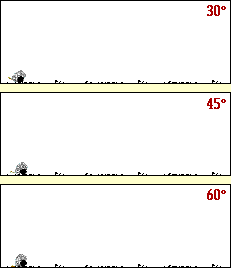
Maximum
Range
A GIF Animation
Imagine a cannonball launched from a cannon at three different
launch angles - 30-degrees, 45-degrees, and 60-degrees. The launch
speed is held constant; only the angle is changed. Imagine as well
that the cannonballs do not encounter a significant amount of air
resistance. How will the trajectories of the three cannonballs
compare? Which cannonball will have the greatest range? Which
cannonball will reach the highest peak height before falling? Which
cannonball will reach the ground first? The animation below depicts
such a situation. The path of the cannonballs are shown;
additionally, the velocity components (horizontal and vertical) are
represented by arrows in the animation.

As can be seen from the above animation, each cannonball
follows a parabolic path. The cannonball launched at a 45-degree
angle had the greatest range. The cannonball launched at a 60-degree
angle had the highest peak height before falling. The cannonball
launched at the 30-degree angle reached the ground first.
An analysis of the velocity components for these three
projectiles reveals reasons for these observations. The peak height
of a projectile is determined by the initial value of the vertical
velocity component. The greater the initial value of Vy, the higher
that a projectile will rise. The projectile launched at 60-degrees
has the greatest Vy, and as such the greatest peak height. The "hang
time" of a projectile is also determined by the initial value of the
vertical velocity component. The smaller the initial value of Vy, the
shorter the hang time. The projectile lauched at 30-degrees has the
smallest Vy, and as such the shortest hang time. The range of a
projectile is determined by two parameters - the initial value of the
horizontal velocity component and the hang time of the projectile. As
can be seen from the animation, the projectile launched at 60-degrees
has the greatest hang time; yet its range is limited by the fact that
the Vx is the smallest of all three angles. The projectile launched
at 30-degrees has the greatest Vx of all three launch angles; yet its
range is limited by the fact that the hang time is so short. The
projectile launched at 45-degree does not win in either
category, yet the fact that it is able to place a strong
showing in each category contributes to its ability to achieve
the greatest range. More sophisticated arguments for why the
45-degree launch angle yields the greatest range exist; yet since
they involve the use of calculus, they are not presented here.
For more information on physical descriptions of motion,
visit
The
Physics Classroom. Specific information is available there on the
following topics:
This page was created by
Tom
Henderson of
Glenbrook South
High School.
Comments and suggestions can be sent by e-mail to
Tom
Henderson.
A hearty thanks is due to lab assistant Bryce Mautner for her
assistance with the graphics and GIF animation.
This page last updated on 3/17/97.
